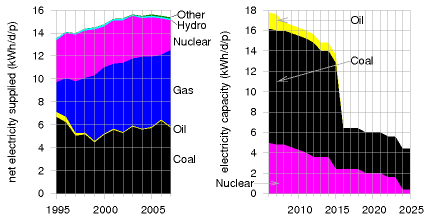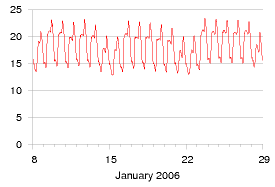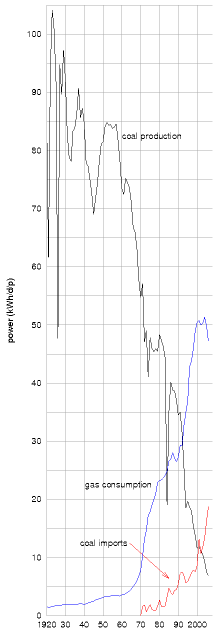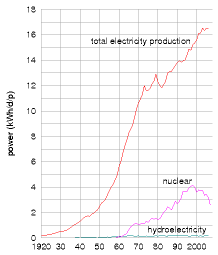K UK energy history
Primary fuel
kWh/d/p
kWh(e)/d/p
Oil
43
Natural gas
47
Coal
20
Nuclear
9
→
3.4
Hydro
0.2
Other renewables
0.8
Table K.1. Breakdown of primary energy sources in the UK (2004–2006).
Figure K.2. Left: UK net electricity supplied, by source, in kWh per day per person. (Another 0.9 kWh/d/p is generated and used by the generators themselves.) Right: the energy gap created by UK power station closures, as projected by energy company EdF. This graph shows the predicted *capacity* of nuclear, coal, and oil power stations, in kilowatt-hours per day per person. The capacity is the maximum deliverable power of a source.
Figure K.3. Electricity demand in Great Britain (in kWh/d per person) during two winter weeks of 2006. The peaks in January are at 6pm each day. (If you’d like to obtain the national demand in GW, the top of the scale, 24 kWh/d per person, is the same as 60 GW per UK.)
| 2006 | 2007 |
|---|
| “Primary units” (the first 2 kWh/d) | 10.73 p/kWh | 17.43 p/kWh |
| “Secondary units” (the rest) | 8.13 p/kWh | 9.70 p/kWh |
Table K.4. Domestic electricity charges (2006, 2007) for Powergen customers in Cambridge, including tax.

Figure K.7. UK production and imports of coal, and UK consumption of gas. Powers are expressed "per person" by dividing each power by 60 million.
Figure K.5. History of UK production of electricity, hydroelectricity, and nuclear electricity. Powers are expressed "per person" by dividing each power by 60 million.
Figure K.6. History of UK use of fossil fuels for electricity production. Powers are expressed "per person" by dividing each power by 60 million.



